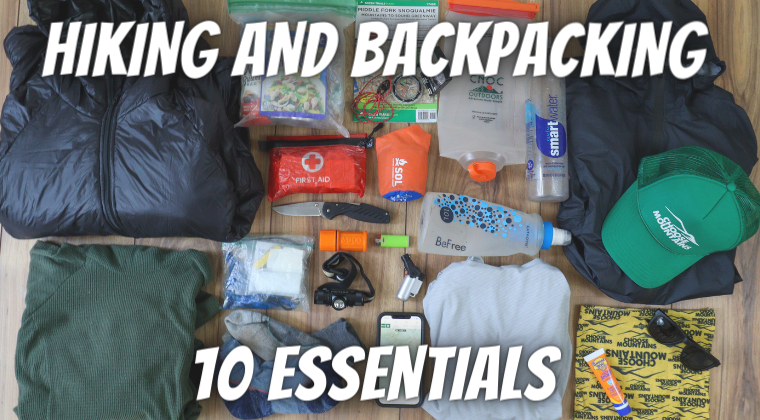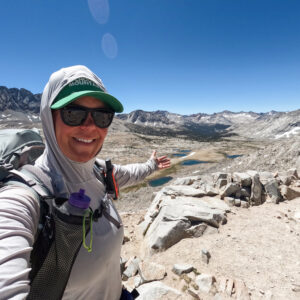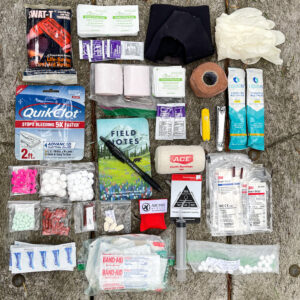
Do you have the 10 Essentials packed in your pack? Do you know what the 10 Hiking Essentials are?
If you’re a hiker and backpacker, you should ALWAYS bring The 10 Essentials with you on every trip you go on, no matter what time of the year you’re going hiking or backpacking and no matter how long you plan on being out on trail.
You may not need to use any of the 10 Essentials on your next trip, but if you ever find yourself in an emergency or get stuck out on trail in the backcountry longer than you planned for, you will be really happy you have them with you.
My biggest recommendation for any hiker or backpacker is to always be prepared for worst case scenario when out in the backcountry.
The original list of Ten Essentials was first put together in the 1930s by The Mountaineers, a Seattle-based organization for climbers and outdoor enthusiasts designed to help people be prepared for emergency situations in the outdoors. Since their creation, the list of Ten Essentials has evolved into a list of systems, rather than individual items.
Every hiker and backpacker should pack the 10 Essentials with them for any trip they go on out in the backcountry, whether it’s a day hike or an overnight backpacking trip.
NAVIGATION
Navigation can include a paper map of the area you plan on travelling in along with a compass. If you bring a paper map and compass, make sure you know how to use these tools ahead of time. Otherwise, they will just be deadweight in your pack.
Navigation can also include digital maps on your smartphone using a GPS app like Gaia GPS, AllTrails or the FarOut app. Using GPS can help you accurately find your location on a digital map. If you plan on going the digital map route, make sure your smartphone is fully charged, you have a way to charge your device on trail if your battery dies, know how to use the GPS apps before getting on trail and make sure you download your digital map onto your smartphone before you leave WiFi and cell service.
Electronics can fail. Batteries can die. The nice thing about a paper map and a compass is that they don’t need batteries in order for them to work. You just need to know how to use them when out on trail. Consider taking a navigation class to improve your map reading skills and learn how to feel more comfortable using a compass.
ILLUMINATION
In case you ever get stuck out on trail at night, you’ll want to have some sort of light source with you. You could use the flashlight feature on your smartphone, but a headlamp is the preferred choice for most hikers and backpackers. A headlamp will allow you to keep your hands free, whether you’re cooking dinner at camp, setting up camp in the dark or night hiking. If you carry a headlamp that requires batteries, make sure you carry extra batteries just in case. If your headlamp is powered by USB, make sure you have a way to charge your headlamp should you need to recharge it when out on trail.
SHELTER
You’ll always want to carry some sort of emergency shelter to help protect you from wind and rain in case you get stranded or injured when out on trail. If you’re day hiking, some lightweight shelter options include an ultralight emergency tarp, an emergency bivy or space blanket or even a large plastic trash bag.
If you’re backpacking, you will more than likely have a shelter system already packed with you in the form of a tent.
EXTRA CLOTHING
Just in case you get stuck out on trail longer than you anticipated or you get caught in bad weather, you’ll want to have extra clothing that can act as insulation, which will help you stay warm in wet, windy or cold conditions.
Some extra clothing options can include a puffy jacket, a rain jacket, a fleece and a couple extra pair of socks. Whether I’m day hiking or backpacking, I always pack a puffy jacket, my rain jacket, a fleece and at least two extra pairs of socks with me, no matter where I’m traveling to and what the weather forecast says.
EXTRA WATER
It’s not only important to make sure you bring enough water with you for your trip, but you’ll also want to bring a way to treat dirty water when out on trail.
For each trip I go on, whether it’s a day hike or an overnight backpacking trip, I always pack a bottle to keep clean drinking water in (this can be a Nalgene bottle, Smart Water bottle or a hydration reservoir), a collapsible container to collect dirty water in and a water filter. I always bring a water filter with me anytime I’m in the backcountry, just in case I run out of drinking water and need to filter water during my trip.
I also carry water purification tablets in my first aid kit as a backup for my water filter because they’re light and just in case anything happens to my water filter. This way I still have a way to treat dirty water and make it safe to drink.
EXTRA FOOD
Always carry at least one extra day’s worth of food, just in case you get stuck out on trail longer than you anticipated. An extra day’s worth of food could consist of snacks like bars, nuts, trail mix, dried fruit, peanut butter packets, freeze dried snacks, chicken or tuna pouches or jerky. Ideally these are food options you don’t have to cook, doesn’t need water to make and has a relatively long shelf life. Something non-perishable.
SUN PROTECTION

When you’re outdoors, especially if you’re traveling in an exposed area, you’ll want to make sure you protect all of your exposed skin with some sort of sun protection to help prevent sunburn, premature skin aging, skin cancer and even snow blindness.
Some forms of sun protection can include sunscreen that offers a sun protection factor or SPF of at least 15 or higher. I recommend using something with at least SPF 30. Sunglasses, a hat with a wide brim, a neck gaiter or a Buff and even sun-protection clothing. I personally prefer a thin, long-sleeved sun shirt that I can sweat in comfortably while protecting my skin from the sun.
FIRE
In case of an emergency, you’ll want to have something reliable that you can use for starting and maintaining a fire. This could be a disposable lighter, storm proof matches and some sort of fire starter.
KNIFE and GEAR REPAIR
Having a knife can be handy for gear repair, food preparation, first aid, making kindling and other emergency needs. A basic knife could have a single foldout blade. You can also carry with you a multitool that has several different features including a nail file, toothpick, screwdriver and even a pair of foldout scissors.
In my Gear Repair Kit, I carry things that I can use to repair various pieces of gear when out on trail. On my trekking poles, I also wrap duct tape on them. This makes it so that the duct tape is always easily accessible since I most likely will always have my trekking poles in my hands. I can visually see how much duct tape I have left after using it, making it easy to know when I need to add more duct tape to my trekking poles on my next trip back into town.
I also carry zip ties (I actually used one of these to repair a pair of gaiters I was wearing on my most recent backpacking trip), hand warmers, tenacious tape, which I used to help repair my tent after a mice break during one of my trips last summer, small, single use tubes of Krazy glue, which are great for repairing and piecing back together shoes when out on trail and a patch kit for my inflatable sleeping pad. Your Gear Repair Kit items should reflect items needed to possibly repair the gear you plan on using when out on trail.
FIRST AID KIT

Not only is it important to have a backcountry first aid kit, but it’s also equally important to know how to use all of the items in your first aid kit. You can either opt for a pre-assembled first aid kit, which takes the guesswork out of building your own or put together your own backpacking first aid kit based on your specific needs.
Inside my backpacking first aid kit, I include things such as a blister repair kit including Leukotape tape, a safety pin, moleskin, alcohol wipes and triple antibiotic ointment.
I also have in my Backpacking First Aid Kit:
- Bandages in various sizes
- A syringe
- Swiss Army Knife
- Pair of nail clippers
- Over the counter medications including aspirin, Ibuprofen, Tylenol, urinary pain relief, Imodium and antihistamine
- A couple prescription medications including one to treat Giardia and Diamox for altitude sickness
- Electrolytes
- Water purification tablets
- A pair of latex gloves
- A mini, disposable CPR mask
- An ACE bandage
- An ankle brace
- SWAT-T, a stretch and tuck tourniquet
- Quick Clot to help stop bleeding
- A pen and notebook along with a patient assessment card
- A stuff sack to store my Backpacking First Aid Kit in
The length of your trip and the number of people in your group will impact the contents you’ll need in your first aid kit.
These are the 10 Essentials I always carry with me for any trip I’m going on in the backcountry, whether it’s a day hike or an overnight backpacking trip. Having these 10 Essentials will help any hiker or backpacker be better prepared for worst case scenario, should they have to spend more time out on trail than I originally anticipated.
Hikers and backpackers, remember, you should ALWAYS be prepared for worst case scenario when going out in the backcountry. Get in the habit of always bringing The 10 Essentials with you on every trip you go on, no matter what time of the year you’re going hiking or backpacking and no matter how long you plan on being out on trail. You may not need to use any of the 10 Essentials on your next trip, but if you ever find yourself in an emergency or get stuck out on trail in the backcountry longer than you planned for, you will be really happy you have your 10 Essentials with you.
Ladies, have you been thinking about wanting to go on a solo day hike or overnight backpacking trip this year? Do you want to feel more comfortable, confident and self-reliant for your solo adventures in the backcountry? If so, I have something special for you!
I’ve created The Confident Solo Female Backpacker System!!
Whether you’re a beginner or a well-seasoned female backpacker, this comprehensive, self-paced online backpacking program specifically for women will walk you through, step by step, everything you need to know in order to plan, prepare and build up your confidence to comfortably go on either your FIRST or NEXT solo backpacking trip.
Interested in learning more about the program I’ve put together and how I can help you achieve your hiking and backpacking goals this year? Sign up for a free, one-on-one Zoom call to chat with me and see if you’d be a perfect fit for this program. CLICK HERE for more details.
Disclaimer: The-Hungry-Hiker.com is a participant in the Amazon Affiliate Links and AvantlInks Program, affiliate advertising programs designed to provide a means for sites to earn advertising fees by advertising and linking to Amazon.com and other affiliated sites at no cost to you. Please note, I only link to products and services I personally use and trust.

14 Comments on What are the 10 Essentials? Hiking Essentials for Hikers & Backpackers